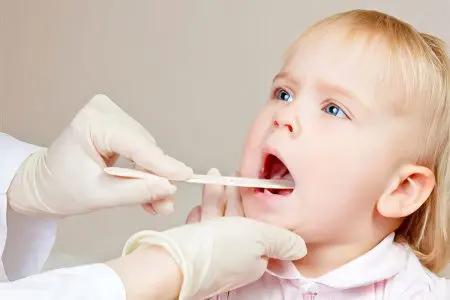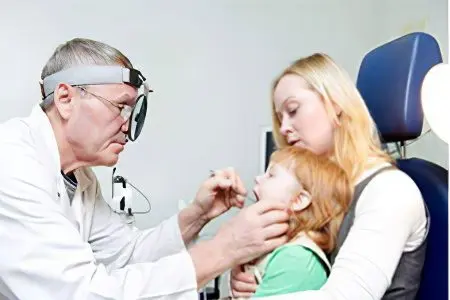Contents

The tonsils are classified as organs of the human immune system, they meet and trap microorganisms that are inhaled with air, so they often become inflamed.
Most often, the pathological process on the tonsils is acute. The disease begins with a sharp sore throat when swallowing, general weakness, fever. Some patients complain of aches, chills, headaches. Submandibular lymph nodes in patients are usually enlarged and painful on palpation.
The inflammatory process should not be ignored, as this leads to severe complications. The disease can go into a chronic form, which is treated for a long time and difficult.
The causes of inflammation of the tonsils today are quite well understood. The disease responds well to therapy and, with timely treatment, does not threaten serious complications. Inadequate treatment or late access to a doctor can cause serious consequences. Today, the fact has already been proven that rheumatic heart disease, myocarditis, and pyelonephritis develop against the background of angina.
Tonsils – what are they and why are they needed?
The tonsils are represented by lymphoid tissue, which provides protection for a person, that is, it refers to the organs of the immune system. The tonsils prevent harmful flora from entering the respiratory tract.
Lymphoid tissue contains lymphocytes. These cells are actively fighting microbes, viruses and fungi, preventing them from multiplying. The tissue of the tonsils is loose, so representatives of the pathogenic flora linger in it. If protection is provided at the proper level, then they will simply be destroyed by lymphocytes.
The tonsils (or palatine tonsils, which are located between the palatine arches) are an accumulation of lymphoid tissue, which is designed to protect the respiratory system. Paired are the tubal tonsils, which are located in the pharynx. If you just look into the mouth, you will not be able to see them. They are rarely exposed to inflammation.
The solitary tonsils include the pharyngeal and lingual tonsils. The pharyngeal tonsil is located at the arch of the pharyngeal wall. It is called adenoids, and when it is inflamed, they indicate adenoiditis. It most often affects young children. In adults, it undergoes a reverse development. The lingual tonsil is located under the tongue at the back. She flares up less often than others.

Causes of inflammation of the tonsils

Inflammation of the tonsils is most often caused by infections that are provoked by a viral or bacterial flora.
Its representatives enter the tonsils through the nose and through the mouth, since most of them are transmitted by airborne droplets. They linger on the mucous membrane and provoke its inflammation.
Infectious agents that most often lead to illness:
Staphylococci.
Streptococci.
Adenoviruses.
Herpes virus.
Haemophilus influenzae.
Mycoplasmas.
Humans are exposed to pathogens on a daily basis. However, people do not get sick very often.
An infection develops when several factors simultaneously affect the body at the same time:
Subcooling.
Weakened immunity against the background of a previous illness.
Acute stage of a chronic disease.
Unbalanced diet, beriberi.
Injury to the mucous membranes of the oral cavity.
Emotional shock.
From the place of concentration of the inflammatory process, the final diagnosis will differ:
Acute angina. Inflammation is concentrated in the tonsils, the degree of its intensity varies. Catarrhal angina is characterized by swelling of the mucous membranes, fever up to 38 ° C, mild pain. With follicular angina, all symptoms intensify. If you examine the surface of the tonsils, then you can see a white coating on them. The third type of angina is lacunar inflammation. In this case, purulent masses accumulate in the folds of the tonsils. This leads not only to severe pain, but also to the appearance of bad breath.
Chronic angina. This form of the disease develops in people who have not received adequate therapy for acute inflammation. From time to time, angina will remind of itself. If you examine the tonsils of a person with chronic tonsillitis, then you can see white plugs on them, which are concentrated in the gaps. At the same time, a person may not complain about a sore throat.
Adenoiditis. With this disease, the inflammatory process will be concentrated in the pharyngeal tonsil. A person’s nasal breathing worsens, discomfort in the throat appears, mucous membranes swell. The disease tends to become chronic.
Symptoms of inflammation of the glands

Symptoms that characterize the inflammatory process in the tonsils may vary, although slightly.
Common signs of the disease include:
An increase in body temperature to high levels.
Swelling of the mucous membrane of the oropharynx, hyperemia of the mucous membranes.
Cough.
Runny nose. With angina, this symptom is most often absent.
General physical weakness.
If a person is infected with herpetic sore throat, then in addition to sore throat and high body temperature, he has discomfort in the abdomen, and a small rash is visible on the tonsils and the back of the throat, which looks like blisters. They contain liquid. In the future, it may become purulent. After opening the blisters, the affected areas are covered with crusts.
If a person has an inflamed lingual tonsil, then this is manifested by the following symptoms:
The tongue swells, it hurts a person to move it.
When chewing and swallowing food, there is a pronounced discomfort.
Pain causes a person to change speech, as intensive movements of the tongue become impossible.
Sometimes the patient notices that his tonsils are inflamed, but he does not experience pain. This symptom may indicate chronic tonsillitis.
The temperature remains within the normal range, as the immune system ceases to make efforts to fight the source of infection.
Inflammation of the palatine tonsils
More often than other tonsils, it is the tonsils that suffer in people. The most common pathology is acute or chronic tonsillitis. This disease becomes dangerous for a person if there is no treatment. Therapy should be selected by a doctor, only in this way it will be possible to make it effective.
The success of treatment is determined by its purposefulness. To do this, you need to know which microorganism caused the inflammatory reaction. For this purpose, the doctor prescribes a bacteriological examination of a throat swab. When the analysis is ready, the doctor will be able to choose the optimal therapy.
Unilateral inflammation of the tonsil
If the infection has affected the tonsil on one side, then this indicates the activation of local immunity. He coped with the pathogenic flora on one of the tonsils on his own and is able to maintain her health.
Sometimes unilateral inflammation is a sign of facial neuritis, lymphadenitis, or other disorders that are not associated with otolaryngological diseases.
Unilateral inflammation requires treatment, which is selected in accordance with the causes of the disease.
Inflamed tonsils in a child

In children, tonsils become inflamed very often. The causes in most cases come down to a viral infection, or to a sore throat.
If cold viruses have entered the child’s body, then most often his condition is not significantly disturbed. After 3 days, there is a significant improvement, which can be compared with recovery.
When a child has a sore throat, the symptoms will be as follows:
An increase in body temperature to high levels.
The appearance of severe pain in the throat, which causes the child to refuse not only food, but also water.
Children become whiny, lose their usual activity.
Breathing becomes heavier.
A white coating appears on the tonsils.
If you can cope with a banal cold on your own, then a sore throat requires medical help. Most often, this disease is treated with antibiotics.
Inflammation of the adenoids is no less common problem than tonsillitis. With adenoiditis, the pharyngeal tonsil increases in size.
Symptoms that would indicate an inflammatory response:
Snore.
The appearance of mucus from the nose, which will have a green or yellow color.
Headache.
Deterioration in the quality of sleep.
Cough.
Voice change. He becomes nasty.
To cope with adenoiditis and prevent further growth of tonsil tissue, you need to consult a doctor.
Which doctor should be consulted for inflammation of the tonsils?

An ENT doctor, that is, an otolaryngologist, is engaged in the diagnosis and treatment of diseases of the tonsils. You need to contact a specialist when the first symptoms of inflammation appear. However, few people rush to consult a doctor if their throat starts to ache a little. It is possible that you will be able to cope with the disease on your own.
However, there are some conditions that require immediate medical attention:
Body temperature reaches 38 ° C and above. It lasts longer than 3 days.
The state of health of the person sharply worsens.
First comes improvement, and then worsening.
Tonsils become inflamed in a child.
In the throat, purulent foci of infection are visible.
Treatment of inflamed tonsils in adults

Most often, it is possible to cope with inflammation at home. However, if the lingual tonsil is affected, hospitalization is always required.
Self-therapy can be carried out only if the person is firmly convinced that the inflammation has a viral basis. A bacterial infection requires a visit to the doctor, as it poses a danger to the health of the patient. Treatment is reduced to taking drugs that are aimed at eliminating the causative agent of inflammation. In addition, it is necessary to direct efforts to alleviate the well-being of a person. Such treatment is called symptomatic.
If a person has decided to cope with inflammation on his own, but after 3 days there is no improvement, then you need to contact a doctor.
Tips to speed up your recovery:
You need to drink as much liquid as possible. In addition to water, it is good to use tea, compotes, broths, fruit drinks.
During the acute phase of the disease, a person should adhere to bed rest.
You don’t have to force yourself to eat. Food is consumed as appetite appears.
If the disease is complicated by suppuration, which cannot be stopped at home, it is recommended for a person to wash the tonsils in the ENT room.
Tonsil removal is rarely resorted to. Surgery is required only when all conservative methods have failed. Also, the help of a surgeon may be needed for patients with chronic tonsillitis and adenoiditis.
Medical correction

If the inflammation of the tonsils is of a viral nature, then it will be possible to confine ourselves to symptomatic therapy, it is recommended to take antiviral drugs that have a local immunomodulatory effect. The body must deal with the infection on its own. You just need to help him a little.
For this purpose, drugs such as:
Sore throat sprays and cough drops.
Throat rinses. The more often a person performs this procedure, the faster recovery will come. Gargling allows you to remove not only the viral flora from the tonsils, but also pus, as well as dead tissue.
Drugs to reduce body temperature.
If the inflammation was caused by the microbial flora, then it will be possible to cope with it only with the use of antibiotics for angina. Their reception allows you to prevent the development of complications. The drug must be recommended by a doctor. The dose is selected depending on the severity of the infection.
If more than 3 days have passed since the start of antibiotic therapy, and there is no effect, then it is necessary to change the drug. This means that the pathogenic flora has resistance to it.
Taking a swab from the throat allows you to establish a representative of the pathogenic flora that caused inflammation and to identify which drugs it responds to. However, the results of the LHC sowing will be known no earlier than in 5-7 days. Postponing treatment for such a long time can be dangerous. Bacterial inflammation, as well as a viral infection, requires symptomatic therapy with obligatory gargling.
Treatment of inflamed tonsils in children

Treatment of inflamed tonsils in children should be pathognomic, that is, aimed at eliminating the cause of the disease.
If a child has ARVI, then he needs to treat his throat, lower his body temperature, and give painkillers.
A bacterial infection requires consultation with a pediatrician. The doctor should prescribe the antibiotic.
Adenoiditis is treated longer than other diseases. For therapy, corticosteroid drugs are used. Vasoconstrictor nasal drops are also used.
In order for the disease to lead to serious complications, parents should consult a doctor in the following situations:
The body temperature remains high, even after taking antipyretic drugs.
White plugs or white coating are visible on the tonsils.
The child is coughing a lot.
Nasal discharge is yellow-green in color.
Prevention of inflammation of the tonsils

To prevent the development of inflammation, you must follow the following recommendations:
Lead a healthy lifestyle.
harden.
Avoid stress.
Do not come into contact with sick people.
Be outdoors more often.
Take vitamins, but only as directed by a doctor.










میرے گلے میں ٹانسلز ھیں اور تھوک نگلنے سے سانس روکنے لگتی ھے کیا کروں